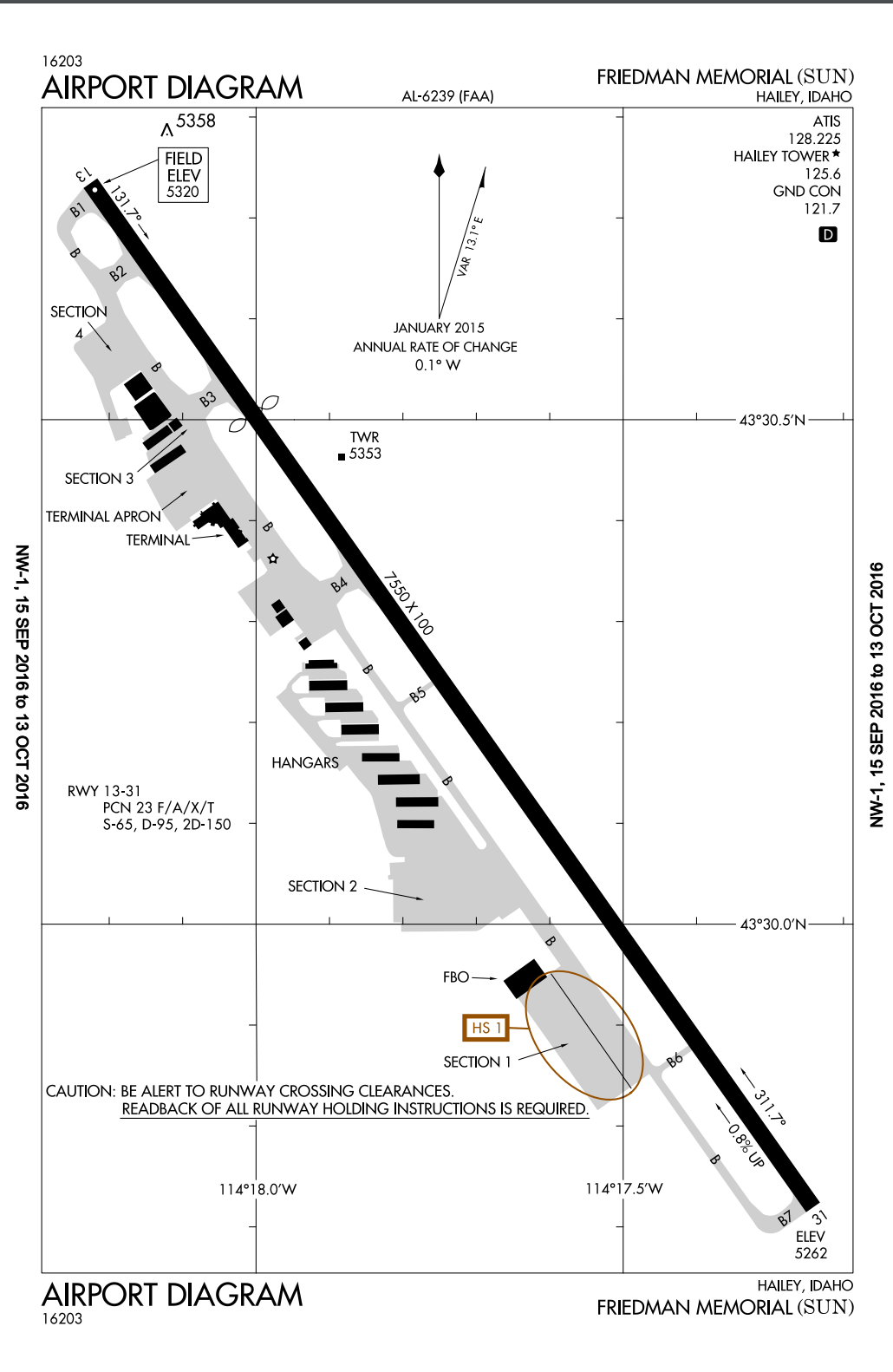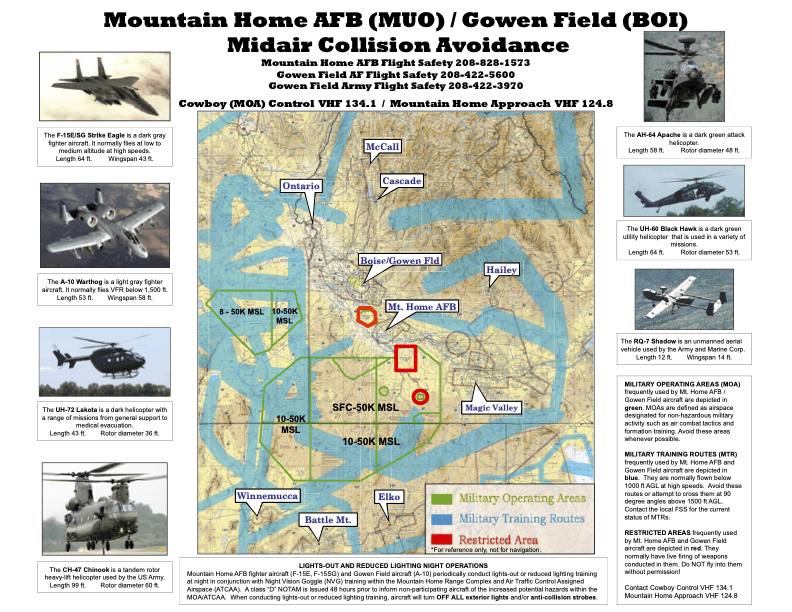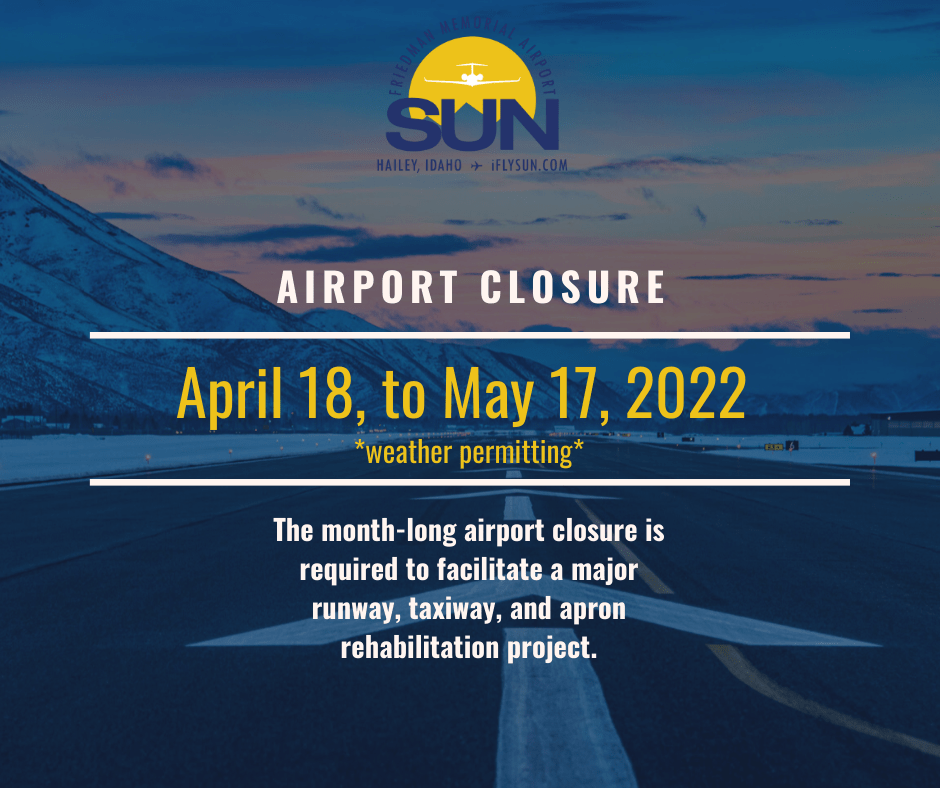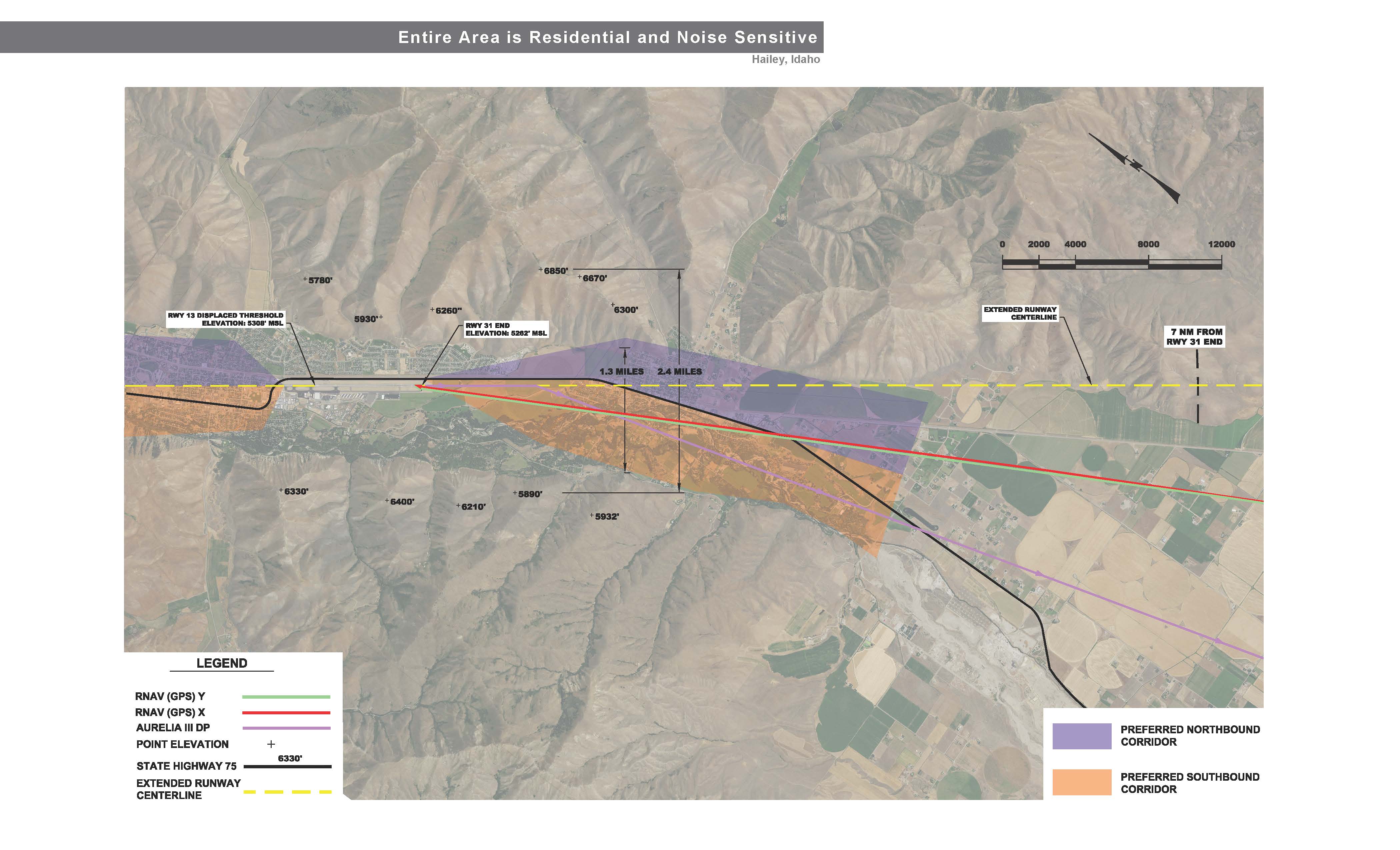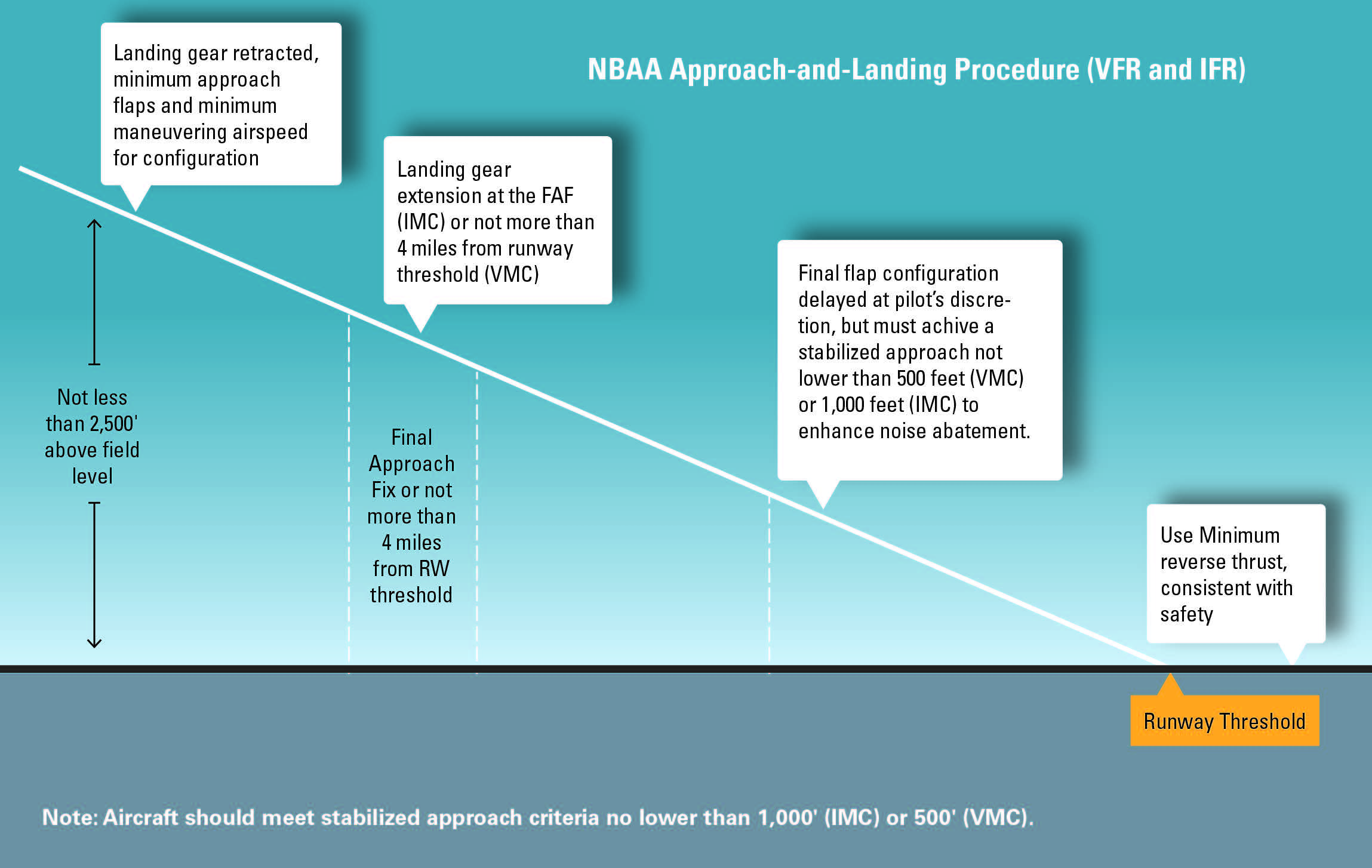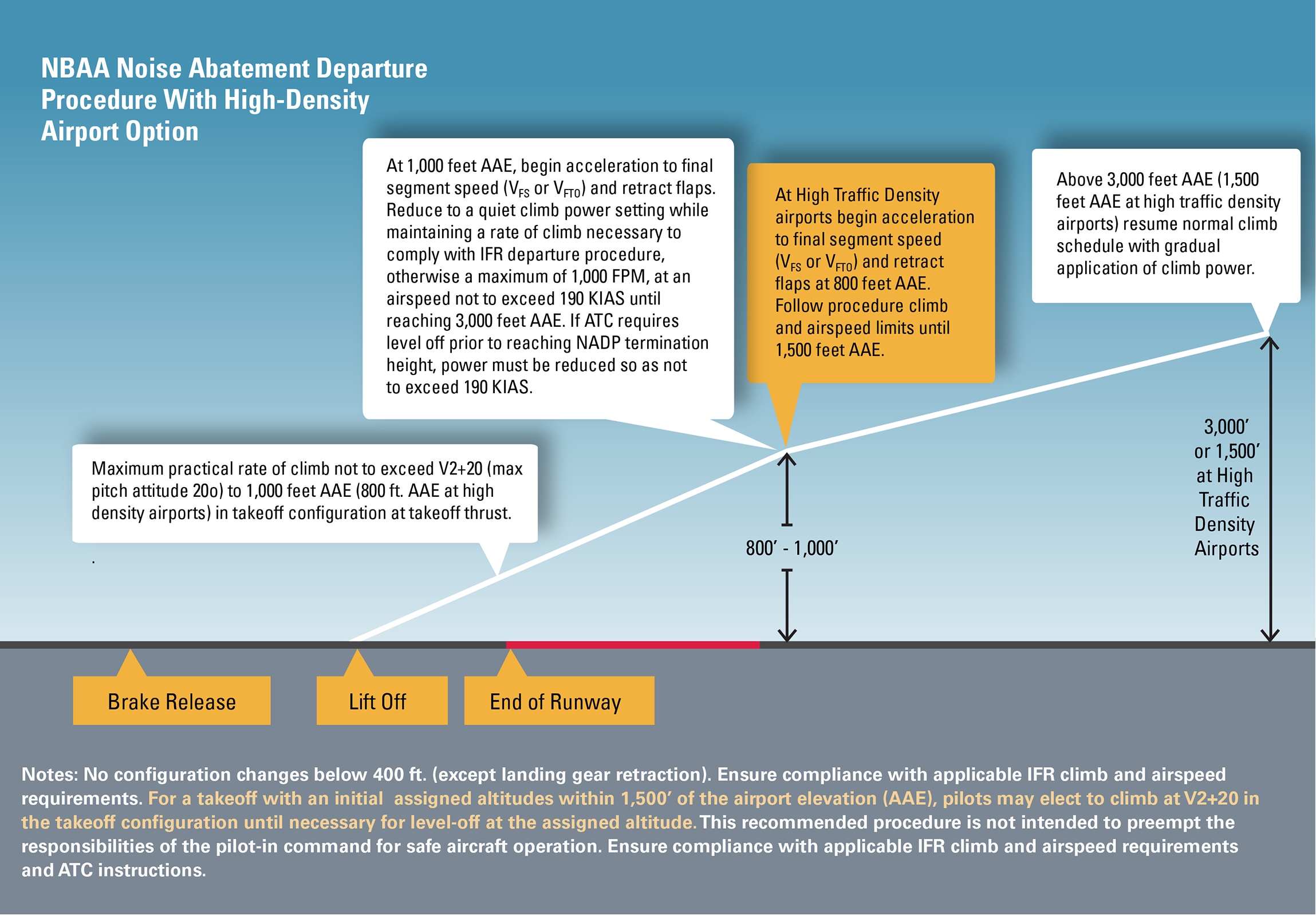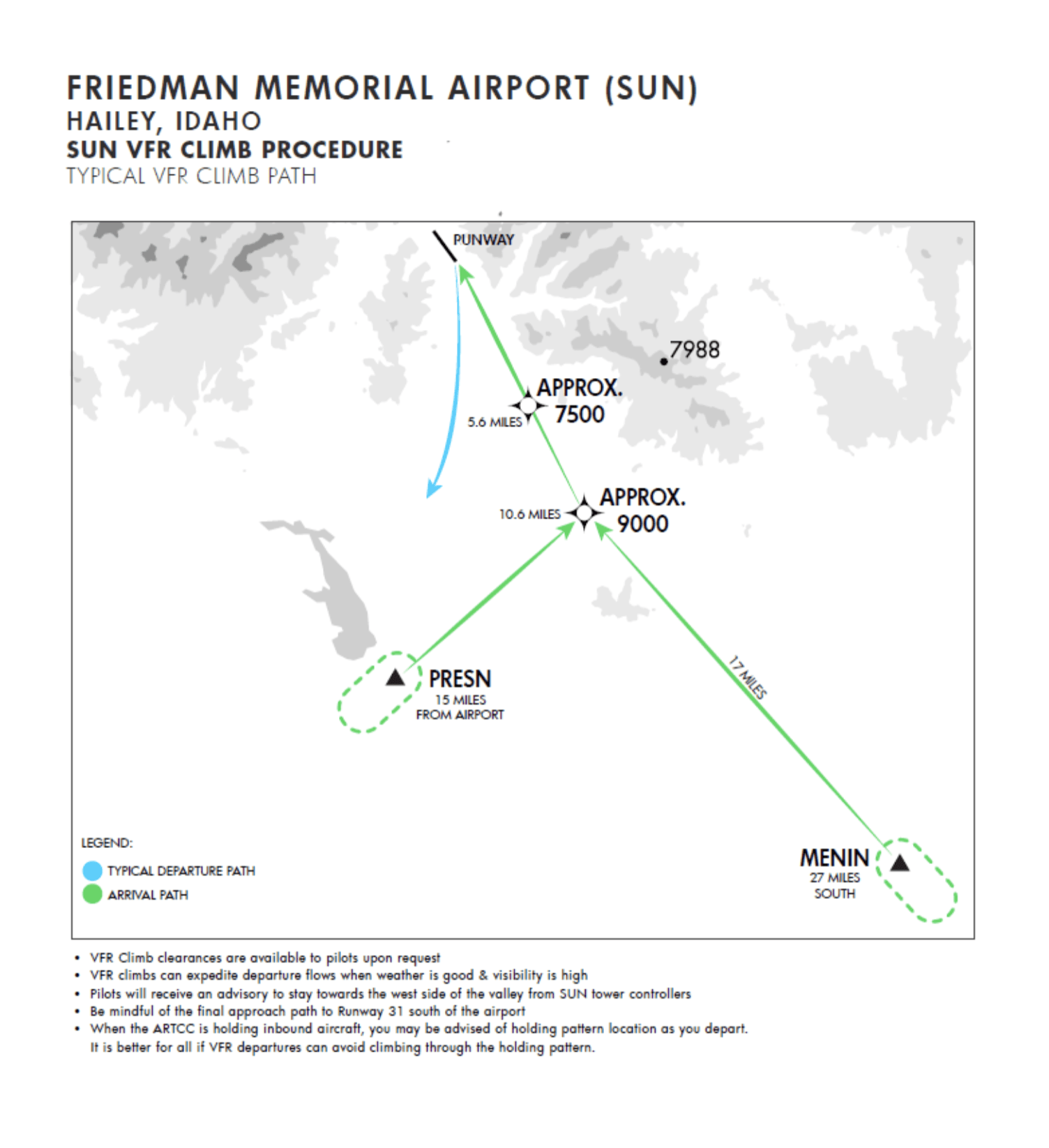
When the weather is VFR, pilots have the option of requesting a VFR climb to an altitude below FL180 to help expedite departure releases and alleviate delays. This can be especially effective when a departure queue has formed, and VFR climb procedures can be used to clear departures with minimal waiting between departures. Please review the attached graphical depiction and reminders of VFR climb procedures below.
If you are planning to ask for a VFR climb from the tower, you can expect instructions to stay on the west side of the valley. If you plan any eastbound turns, keep in mind the location of the final approach path and profile for Runway 31 that extends south of the airport and be mindful of all SUN Tower instructions and advisories (see attached graphic).
When the ARTCC is holding inbound aircraft, you may be advised of holding pattern location as you depart. It is better for all if VFR departures can avoid climbing through the holding pattern.
*click image to enlarge*
Mtn. Home AFB Midair Collision Avoidance
Mountain Home Air Force Base Contact Information
366 Fighter Wing Flight Safety Office: (208-828-1573/2065) MUO Tower: 133.85
366 Fighter Wing Public Affairs: (208-828-6800) MUO Approach: 124.8
Cowboy Control (MOA control): (208-828-4804) Cowboy (MOA) Control: 134.1
MOA Airspace Scheduling: (208-828-2172)
Gowen Field Contact Information
Gowen Field Air Force Flight Safety: (208-422-5600)
Gowen Field Army Flight Safety: (208-422-3970)
The U. S. Air Force is committed to working with the civilian aviation community to make our skies safe:
As part of a continuing public information program, the 366 FW Flight Safety Office would like to educate our civilian counterparts about the intensive military air operations at Mountain Home AFB and adjoining MOAs. By discussing these issues, we hope to heighten awareness and reduce the potential for midair collisions.
In combat, aircraft will operate across a wide range of altitudes and airspeeds to avoid sophisticated surface-to-air missiles, anti-aircraft artillery, and enemy fighters. Pilots must be able to train in the same manner that they would be expected to fight. The military frequently flies at speeds greater than 500 knots. High speed operations include
aircraft intercepts, low altitude navigation, surface attack, air-to-air combat, and close-air support. When typically slower-moving civilian aircraft are added to the mix, the potential for deadly midair collisions rises considerably.
The fighters operating out of Mountain Home AFB may have air-to-air radars but are not equipped with TCAS (collision avoidance system based on transponders). The fighters operating out of Gowen Field are not equipped with radars or TCAS and may fly down to 100ft AGL off low-level routes. Collision avoidance is accomplished primarily through deconfliction by mission planning, adherence to mandatory and recommended FAA procedures, maximum use of IFR and flight following services, and the see-and-avoid concept.
CIVILIAN PILOT RESPONSIBILITIES
A. Entering Mountain Home Radar Control Area: Prior to entering the MUO Class E airspace, contact Mountain Home Approach (124.8) and state the intended flight path and cruising altitude. The controller will acknowledge your intentions.
B. Aircraft in Class E Airspace: Once a participating aircraft has entered Class E airspace, VFR aircraft should not change altitudes without advising the controller. Whenever compliance with an assigned route or heading is likely to compromise pilot responsibility for terrain or obstruction clearance or weather, advise approach control of intended action.
C. Aircraft Departing MUO Control Area: Aircraft departing Mountain Home Air Force Base or Mountain Home Muni after practice approaches should advise departure control of proposed direction of flight and altitude. The controller will assign a beacon code.
D. Aircraft Traversing The MOA : Aircraft traversing through the mountain home range complex at any altitude should contact Mountain Home Approach (124.8) and Cowboy Control (134.1) for real time traffic advisories and MOA hours of operation. THE MOA BOUNDARIES AND ALTITUDES MAY HAVE CHANGED. Please review current publications for new MOA restrictions.
Military Operations Areas are defined as airspace designated for non-hazardous military activity such as acrobatics, air combat tactics, and formation training. The designation informs and segregates non-participating IFR aircraft from the activity. VFR aircraft are not restricted from operating in military operations areas but should exercise extreme caution while flying within a MOA. MOA status changes frequently and can be in use anytime from sunrise to 1200 o’clock midnight from surface to 50,000 feet MSL. FAA flight service station can tell you whether the MOA is active and altitude in use. Cowboy Control at Mountain Home AFB or approach control can also issue real time updates for the local MOAs special use airspace.
MOUNTAIN HOME AFB
LIGHTS-OUT AND REDUCED LIGHTING NIGHT OPERATIONS
Mountain Home AFB Fighter aircraft (F-15E, F-15SG) and Gowen Field aircraft (A-10) periodically conduct lights-out and reduced lighting training at night in conjunction with Night Vision Goggle (NVG) training within the Mountain Home Range Complex (Jarbridge, Owyhee, and Paradise Military Operating Area’s (MOA’s)). A class “D” NOTAM is issued 48 hours prior to inform non-participating aircraft of the increased potential hazards within the MOA.
When conducting lights-out training, fighter aircraft will turn all of their exterior lights off. During reduced lighting operations, they will turn their anti-collision and strobe lights off and will adjust position lights to minimum brightness. In either case, the lack of external lighting, combined with fighter aircraft speed and maneuverability, dramatically increases the hazards for non participating aircraft traversing the MOA using see and avoid rules.
Pilot Information for KSUN
RUNWAY 13/31:
Asphalt, grooved, in good condition.
**For more detailed information on Runway 13/31 please view the FAA Airport Facility Directory.
TOWER OPERATION HOURS
7:00 AM – 11:00 PM Mountain Standard Time
ATIS
128.225 208.788.2108
AWOS
128.225 877-788-2967 208-788-9213
COMMUNICATION
WX 128.225T; Ground 121.7; CTAF 125.6;
FREQUENCIES
UNICOM 122.95; Tower 125.6
LIGHTS
Actvt HIRL Ry 13/31 – CTAF When ATCT clsd. PAPI Ry 31 Oper 24 Hrs.
NAVAIDS
NDB/DME Freq. – 220.0; Radial – 332; Dist. 11 nm
WEIGHT BEARING CAPACITY
- Single Wheel – 65,000 lbs.
- Dual Wheel – 95,000 lbs.
- Two Dual Wheels in Tandem – 150,000 lbs.
NOTES SUMMARY
- Apu Operation Limited to 30 Mins Without Exception
- Bird Activity SE End Ry 31
- Not Rcmdd for Night Use or in Marginal Weather by Unfamiliar Pilots Due to Mountainous Terrain
- Afld Sfc Conditions Not Monitored between the hours of 11:00 PM and 7:00 AM
**For all Notes/Remarks please view the FAA Airport Facility Directory.
SELF-SERVICE FUEL
For more information on self-service fueling at Friedman Memorial Airport, please contact the Fixed Based Operator, Atlantic Aviation.
IMPORTANT LINKS FOR PILOTS
NOTAMs
Noise Abatement Procedures
FAA
Aviation Weather
Recommended Landing Procedure
Avoid landing from the north over the City of Hailey unless weather, aircraft performance, pilot experience and familiarity, or company operations specifications, necessitate otherwise. If landing from the north is necessary, arrivals should proceed inbound on east side of the valley, and/or per ATC instructions. Make modified left base over Hailey cemetery when able.
Notes:
- The Runway 13 threshold is displaced approximately 1,700 ft. The pavement behind the displaced threshold is NOT available for landing.
- Runway 13 slopes downhill approximately 0.74%
Use east side of the valley. Arriving aircraft should stay at or above PAPI glideslope over Bellevue as weather, aircraft performance, and ATC instructions allow. Safety is top priority.
NBAA APPROACH AND LANDING PROCEDURE VFR & IFR
- Landing gear retracted, minimum approach flaps and minimum maneuvering airspeed for configuration (Not less than 2,500 ft. above field elevation).
- Landing gear extension at the FAF (IMC) or not more than 4 miles from runway threshold (VMC).
- Final flap configuration delayed at pilot’s discretion, but must achieve a stabilized approach not lower than 500 feet (VMC) or 1,000 feet (IMC) to enhance noise abatement.
- Use Minimum reverse thrust, consistent with safety.
Note: Aircraft should meet stabilized approach criteria no lower than 1,000’ (IMC) or 500’ (VMC).
For more information, visit the NBAA Noise Abatement Program website.
Recommended Departure Procedures
Avoid landing from the north over the City of Hailey unless weather, aircraft performance, pilot experience and familiarity, or company operations specifications necessitate otherwise.
Piston powered propeller driven aircraft reduce propeller RPM as soon as practical after takeoff.
North Bound-Routing North:
At a good rate of climb, make slight right turn at the departure end. Fly east side of the valley.
North Bound-Routing South:
Turn crosswind north of Hailey at or above pattern altitude.
Strait out Departures:
Climb as fast as practical and to the west side of the valley based on aircraft performance, ATC instructions, and safety considerations.
North Bound Departures:
Climb as fast as practical and to the west side of the valley based on aircraft performance, ATC instructions, and safety considerations. Upon reaching pattern altitude execute left or above downwind north bound.
Jet and Turbo Prop aircraft use aircraft manual noise abatement procedures (NBAA) to 3,000 AGL.
NBAA CLOSE-IN DEPARTURE PROCEDURE
- Maximum practical rate of climb not to exceed V2+20 (max pitch altitude 20o) to 1,000 feet AAE in takeoff configuration at takeoff thrust.
- At 1,000 feet AAE, begin acceleration to final segment speed and retract flaps. Reduce to a quet climb power setting while maintaining a rate of climb necessary to comply with IFR departure procedure, otherwise a maximum of 1,000 FPM, at an airspeed not to exceed 190 KIAS until reaching 3,000 feet AAE. If ATC requires level off prior to reaching NADP termination height, power must be reduced so as not to exceed 190 KIAS.
- Above 3,000 feet AAE resume normal climb schedule with gradual application of climb power.
Notes: No configuration changes below 400 ft. (except landing gear retraction). Ensure compliance with applicable IFR climb and airspeed requirements. For a takeoff with an initial assigned altitudes within 1,500’ of the airport elevation (AAE), pilots may elect to climb at V2+20 in the takeoff configuration until necessary for level-off at the assigned altitude. This recommended procedure is not intended to preempt the reponsibilities of the pilot-in command for safe aircraft operation. Ensure compliance with application IFR climb and airspeed requirements and ATC instructions.
For more information, visit the NBAA Noise Abatement Program website.
Alternate Landing Area
For authorization to use the Alternate Landing Area (ALA), please visit the ALA Requirement page.
Deputy Director Operations & Maintenance
TIM BURKE
1616 Airport Circle
Hailey, ID 83333
208.788.4956 x105
tim@iflysun.com
The Airfield Operations & Emergency Services assures compliance with FAA airport certification mandates which govern airports served by commercial air carriers. The FAA conducts an annual inspection to ensure compliance with federal certification requirements. Operations is also responsible for emergency planning and response, including Aircraft Rescue and Fire Fighting (ARFF) services and other safety requirements. Operations also regularly maintains all airport facilities and operations equipment. It seeks to minimize any adverse impact of aircraft noise on the surrounding community through pilot education and other noise abatement programs.

